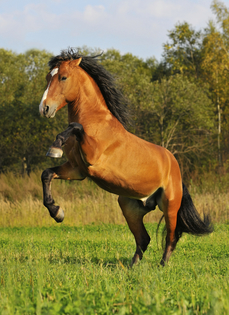
The Most Popular Horse Breeds Of 2019
Equestrian Advice & Guides General Equestrian
Build your business profile for FREE and expose your services to thousands of potential clients!
Create my profile now!
The Mustang, America's wild horse, can amaze and inspire even the non-horse lovers when seen galloping across the plains of unbridled America. Mesteno, in Spanish translating to a word for stray animal is where the word Mustang originated, much like the beginning of Mustangs in America. Spanish conquistadors were the first Europeans to import horses to America and they were the first “modern” horses on North and South American soil. Since horses were completely new to the native people (along with Spaniards and their arsenal), a person sitting atop an unknown animal easily bewildered and intimidated them, turning the horse into a mythical-like icon with special powers instantaneously.
Spanish-bred horses were usually of medium size, had great endurance and were often gaited. Being a nearby neighbor, many Spanish horses were crossed with Barb horses from Northern Africa but purebred Andalusians also made their way overseas as well as Spanish Jennets, Garranos, Sorraias, Asturians, and Galicans. While Andalusian horses are slightly taller and muscular and used in battle with heavy armor, Jennets, Garranos, Sorraias, Asturians and Galicans were smaller, hardier horses, perfect for the early Spanish explorers and missionaries. They packed and hacked through the wilderness of the Americas and are also responsible for the Peruvian Paso, Paso Fino and other breeds. Eventually as Spaniards made their way into Mexico's inland and settled throughout Mexico and the southern United States, their horses became detached and free roaming, or purposely let loose or left behind, creating herds of unclaimed horses of various bloodlines and body types.

Wild Mustangs now live on limited, restricted land in various parts of the United States. This land challenges and accepts only the toughest of horses to survive on it, resulting in generally smaller, more compact horses than the estimated 2 million Mustangs that roamed the wild west until the beginning of the 20th century. Fine bred cavalry horses, draft horses, and light riding horses of early pioneers also make up the ancestors of today's horses but due to harsh living conditions, most Mustangs don't top over 16 hands, being an average 14 hands tall and weigh anything from 700 to 900 pounds. Mustangs have a sturdy frame, strong legs, short backs, often wide heads and can be found in any coat color of horse under the sun.
The United States Bureau of Land Management, or the BLM, is responsible for reporting and monitoring wild Mustang populations that can be found primarily in Nevada, but herds also exist in parts of Wyoming, Montana, and Oregon. Small populations exist in Alberta and British Columbia but are not recognized under the BLM.
Over population and not enough free room to roam has caused many controversies and debates on what to do with the wild horses that often compete with ranchers livestock for grazeable grass on public BLM land but many services are offered to protect and adopt out Mustangs. The BLM offers routine Mustang adoptions for a minimum of $125 and is a great resource to go to when interested in learning more about Mustangs and their environment. The BLM also cooperates with a handful of correctional facilities in western United States where inmates are responsible for the training and management of Mustangs that later go on to be adopted.
To promote the adoption of Mustangs, the Mustang Heritage Foundation was created to support the BLM and promote the Mustang as a trainable, usable horse. Since 2007, large sponsors, the BLM and the MHF have coordinated “Extreme Mustang Makeovers” across the United States, challenging professional horse trainers to promote their abilities while simultaneously promoting Mustang adoption, awareness and protection. This has been largely a success, raising over 6 million dollars for the protection and preservation of the American Mustang and has raised cognizance of the Mustang as a completely suitable and competitive horse in the show pen.
While typically not for beginners, they make great horses to learn horsemanship from. Mustangs are commonly found competing in rodeo events such as barrel racing and pole bending, reining, roping, endurance rides, to even jumping competitions in the Olympics. What?! A Mustang in the Olympics!? It's true! At the 1920 Olympics in Antwerp, show jumper Major Henry Allen rode a Mustang named Don and claimed 6th place among Europe's highly bred cavalry horses.
